Yeming Wen
Synthesize, Partition, then Adapt: Eliciting Diverse Samples from Foundation Models
Nov 11, 2024Abstract:Presenting users with diverse responses from foundation models is crucial for enhancing user experience and accommodating varying preferences. However, generating multiple high-quality and diverse responses without sacrificing accuracy remains a challenge, especially when using greedy sampling. In this work, we propose a novel framework, Synthesize-Partition-Adapt (SPA), that leverages the abundant synthetic data available in many domains to elicit diverse responses from foundation models. By leveraging signal provided by data attribution methods such as influence functions, SPA partitions data into subsets, each targeting unique aspects of the data, and trains multiple model adaptations optimized for these subsets. Experimental results demonstrate the effectiveness of our approach in diversifying foundation model responses while maintaining high quality, showcased through the HumanEval and MBPP tasks in the code generation domain and several tasks in the natural language understanding domain, highlighting its potential to enrich user experience across various applications.
Grounding Data Science Code Generation with Input-Output Specifications
Feb 12, 2024Abstract:Large language models (LLMs) have recently demonstrated a remarkable ability to generate code from natural language (NL) prompts. However, in the real world, NL is often too ambiguous to capture the true intent behind programming problems, requiring additional input-output (I/O) specifications. Unfortunately, LLMs can have difficulty aligning their outputs with both the NL prompt and the I/O specification. In this paper, we give a way to mitigate this issue in the context of data science programming, where tasks require explicit I/O specifications for clarity. Specifically, we propose GIFT4Code, a novel approach for the instruction fine-tuning of LLMs with respect to I/O specifications. Our method leverages synthetic data produced by the LLM itself and utilizes execution-derived feedback as a key learning signal. This feedback, in the form of program I/O specifications, is provided to the LLM to facilitate instruction fine-tuning. We evaluated our approach on two challenging data science benchmarks, Arcade and DS-1000. The results demonstrate a significant improvement in the LLM's ability to generate code that is not only executable but also accurately aligned with user specifications, substantially improving the quality of code generation for complex data science tasks.
Batched Low-Rank Adaptation of Foundation Models
Dec 09, 2023



Abstract:Low-Rank Adaptation (LoRA) has recently gained attention for fine-tuning foundation models by incorporating trainable low-rank matrices, thereby reducing the number of trainable parameters. While LoRA offers numerous advantages, its applicability for real-time serving to a diverse and global user base is constrained by its incapability to handle multiple task-specific adapters efficiently. This imposes a performance bottleneck in scenarios requiring personalized, task-specific adaptations for each incoming request. To mitigate this constraint, we introduce Fast LoRA (FLoRA), a framework in which each input example in a minibatch can be associated with its unique low-rank adaptation weights, allowing for efficient batching of heterogeneous requests. We empirically demonstrate that FLoRA retains the performance merits of LoRA, showcasing competitive results on the MultiPL-E code generation benchmark spanning over 8 languages and a multilingual speech recognition task across 6 languages.
A Language-Agent Approach to Formal Theorem-Proving
Oct 06, 2023Abstract:Language agents, which use a large language model (LLM) capable of in-context learning to interact with an external environment, have recently emerged as a promising approach to control tasks. We present the first language-agent approach to formal theorem-proving. Our method, COPRA, uses a high-capacity, black-box LLM (GPT-4) as part of a policy for a stateful backtracking search. During the search, the policy can select proof tactics and retrieve lemmas and definitions from an external database. Each selected tactic is executed in the underlying proof framework, and the execution feedback is used to build the prompt for the next policy invocation. The search also tracks selected information from its history and uses it to reduce hallucinations and unnecessary LLM queries. We evaluate COPRA on the miniF2F benchmark for Lean and a set of Coq tasks from the Compcert project. On these benchmarks, COPRA is significantly better than one-shot invocations of GPT-4, as well as state-of-the-art models fine-tuned on proof data, at finding correct proofs quickly.
Natural Language to Code Generation in Interactive Data Science Notebooks
Dec 19, 2022



Abstract:Computational notebooks, such as Jupyter notebooks, are interactive computing environments that are ubiquitous among data scientists to perform data wrangling and analytic tasks. To measure the performance of AI pair programmers that automatically synthesize programs for those tasks given natural language (NL) intents from users, we build ARCADE, a benchmark of 1082 code generation problems using the pandas data analysis framework in data science notebooks. ARCADE features multiple rounds of NL-to-code problems from the same notebook. It requires a model to understand rich multi-modal contexts, such as existing notebook cells and their execution states as well as previous turns of interaction. To establish a strong baseline on this challenging task, we develop PaChiNCo, a 62B code language model (LM) for Python computational notebooks, which significantly outperforms public code LMs. Finally, we explore few-shot prompting strategies to elicit better code with step-by-step decomposition and NL explanation, showing the potential to improve the diversity and explainability of model predictions.
A Simple Approach to Improve Single-Model Deep Uncertainty via Distance-Awareness
May 01, 2022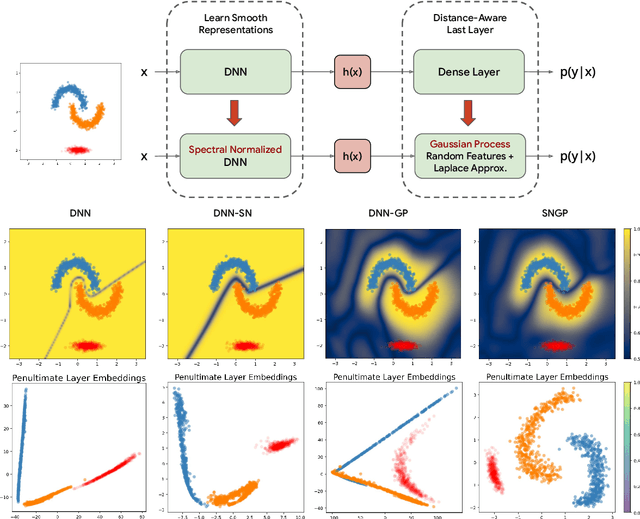
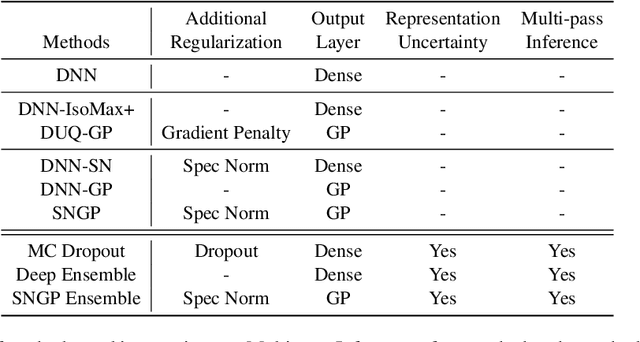
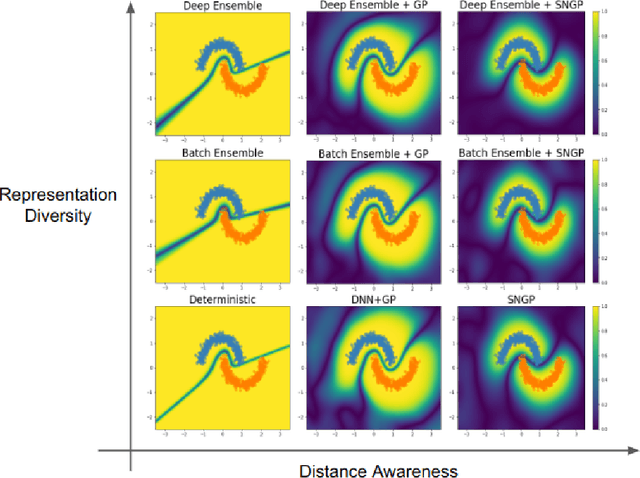
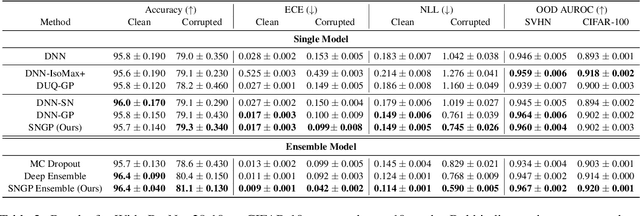
Abstract:Accurate uncertainty quantification is a major challenge in deep learning, as neural networks can make overconfident errors and assign high confidence predictions to out-of-distribution (OOD) inputs. The most popular approaches to estimate predictive uncertainty in deep learning are methods that combine predictions from multiple neural networks, such as Bayesian neural networks (BNNs) and deep ensembles. However their practicality in real-time, industrial-scale applications are limited due to the high memory and computational cost. Furthermore, ensembles and BNNs do not necessarily fix all the issues with the underlying member networks. In this work, we study principled approaches to improve uncertainty property of a single network, based on a single, deterministic representation. By formalizing the uncertainty quantification as a minimax learning problem, we first identify distance awareness, i.e., the model's ability to quantify the distance of a testing example from the training data, as a necessary condition for a DNN to achieve high-quality (i.e., minimax optimal) uncertainty estimation. We then propose Spectral-normalized Neural Gaussian Process (SNGP), a simple method that improves the distance-awareness ability of modern DNNs with two simple changes: (1) applying spectral normalization to hidden weights to enforce bi-Lipschitz smoothness in representations and (2) replacing the last output layer with a Gaussian process layer. On a suite of vision and language understanding benchmarks, SNGP outperforms other single-model approaches in prediction, calibration and out-of-domain detection. Furthermore, SNGP provides complementary benefits to popular techniques such as deep ensembles and data augmentation, making it a simple and scalable building block for probabilistic deep learning. Code is open-sourced at https://github.com/google/uncertainty-baselines
Neural Program Generation Modulo Static Analysis
Nov 22, 2021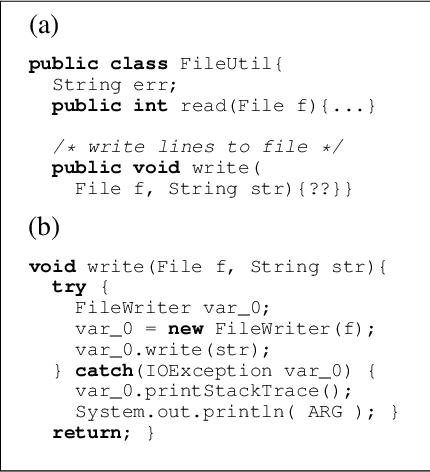
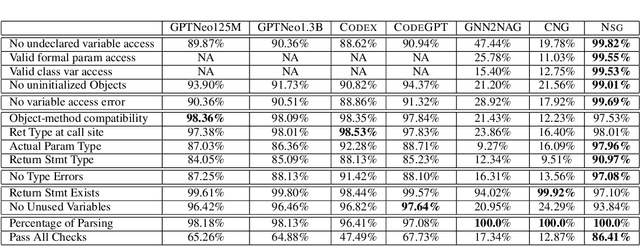
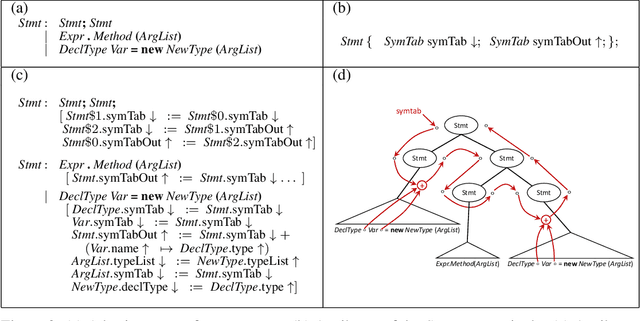

Abstract:State-of-the-art neural models of source code tend to be evaluated on the generation of individual expressions and lines of code, and commonly fail on long-horizon tasks such as the generation of entire method bodies. We propose to address this deficiency using weak supervision from a static program analyzer. Our neurosymbolic method allows a deep generative model to symbolically compute, using calls to a static-analysis tool, long-distance semantic relationships in the code that it has already generated. During training, the model observes these relationships and learns to generate programs conditioned on them. We apply our approach to the problem of generating entire Java methods given the remainder of the class that contains the method. Our experiments show that the approach substantially outperforms state-of-the-art transformers and a model that explicitly tries to learn program semantics on this task, both in terms of producing programs free of basic semantic errors and in terms of syntactically matching the ground truth.
Uncertainty Baselines: Benchmarks for Uncertainty & Robustness in Deep Learning
Jun 07, 2021
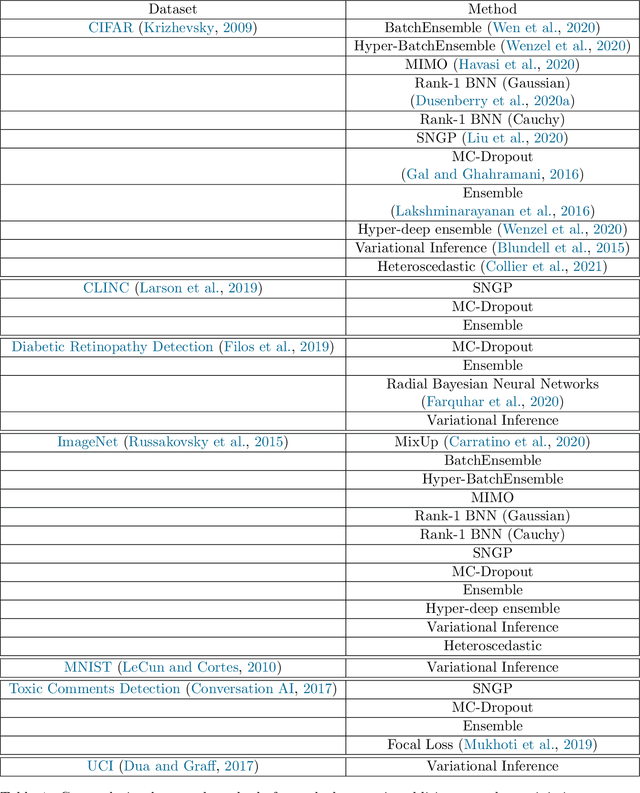
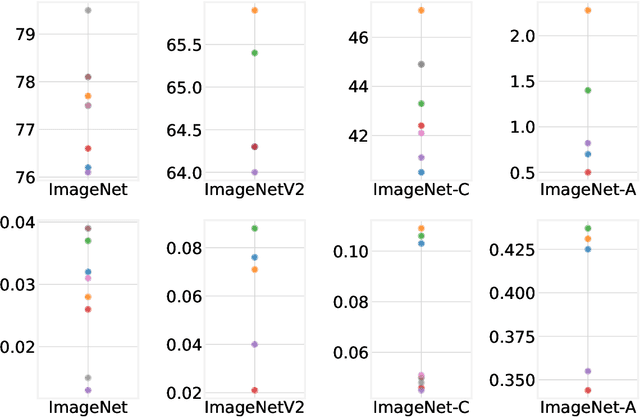

Abstract:High-quality estimates of uncertainty and robustness are crucial for numerous real-world applications, especially for deep learning which underlies many deployed ML systems. The ability to compare techniques for improving these estimates is therefore very important for research and practice alike. Yet, competitive comparisons of methods are often lacking due to a range of reasons, including: compute availability for extensive tuning, incorporation of sufficiently many baselines, and concrete documentation for reproducibility. In this paper we introduce Uncertainty Baselines: high-quality implementations of standard and state-of-the-art deep learning methods on a variety of tasks. As of this writing, the collection spans 19 methods across 9 tasks, each with at least 5 metrics. Each baseline is a self-contained experiment pipeline with easily reusable and extendable components. Our goal is to provide immediate starting points for experimentation with new methods or applications. Additionally we provide model checkpoints, experiment outputs as Python notebooks, and leaderboards for comparing results. Code available at https://github.com/google/uncertainty-baselines.
Combining Ensembles and Data Augmentation can Harm your Calibration
Oct 19, 2020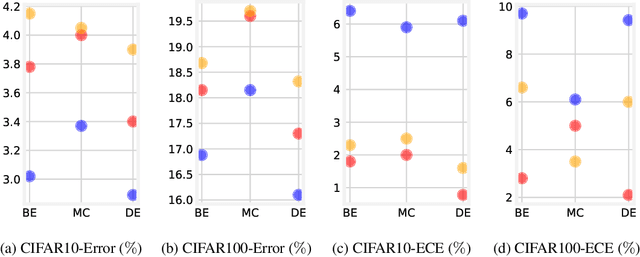
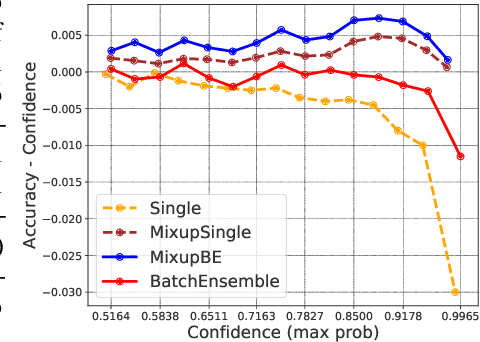


Abstract:Ensemble methods which average over multiple neural network predictions are a simple approach to improve a model's calibration and robustness. Similarly, data augmentation techniques, which encode prior information in the form of invariant feature transformations, are effective for improving calibration and robustness. In this paper, we show a surprising pathology: combining ensembles and data augmentation can harm model calibration. This leads to a trade-off in practice, whereby improved accuracy by combining the two techniques comes at the expense of calibration. On the other hand, selecting only one of the techniques ensures good uncertainty estimates at the expense of accuracy. We investigate this pathology and identify a compounding under-confidence among methods which marginalize over sets of weights and data augmentation techniques which soften labels. Finally, we propose a simple correction, achieving the best of both worlds with significant accuracy and calibration gains over using only ensembles or data augmentation individually. Applying the correction produces new state-of-the art in uncertainty calibration across CIFAR-10, CIFAR-100, and ImageNet.
Efficient and Scalable Bayesian Neural Nets with Rank-1 Factors
May 14, 2020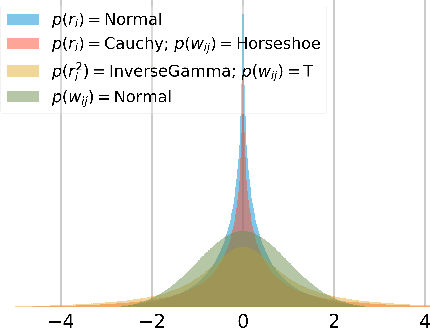

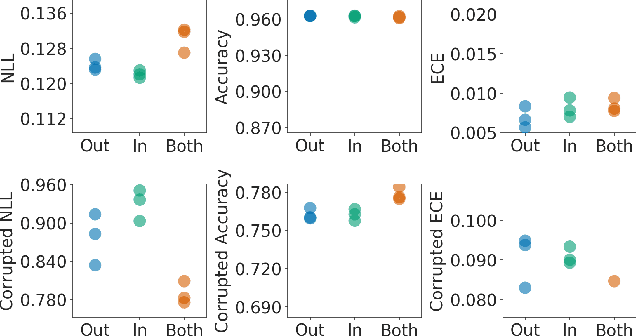
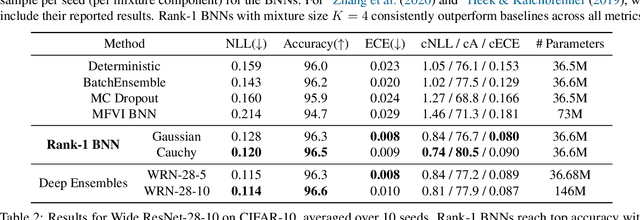
Abstract:Bayesian neural networks (BNNs) demonstrate promising success in improving the robustness and uncertainty quantification of modern deep learning. However, they generally struggle with underfitting at scale and parameter efficiency. On the other hand, deep ensembles have emerged as alternatives for uncertainty quantification that, while outperforming BNNs on certain problems, also suffer from efficiency issues. It remains unclear how to combine the strengths of these two approaches and remediate their common issues. To tackle this challenge, we propose a rank-1 parameterization of BNNs, where each weight matrix involves only a distribution on a rank-1 subspace. We also revisit the use of mixture approximate posteriors to capture multiple modes, where unlike typical mixtures, this approach admits a significantly smaller memory increase (e.g., only a 0.4% increase for a ResNet-50 mixture of size 10). We perform a systematic empirical study on the choices of prior, variational posterior, and methods to improve training. For ResNet-50 on ImageNet, Wide ResNet 28-10 on CIFAR-10/100, and an RNN on MIMIC-III, rank-1 BNNs achieve state-of-the-art performance across log-likelihood, accuracy, and calibration on the test sets and out-of-distribution variants.
 Add to Chrome
Add to Chrome Add to Firefox
Add to Firefox Add to Edge
Add to Edge